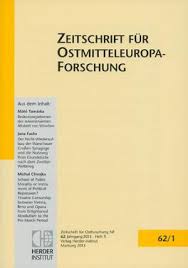Die friderizianische Kolonisation Preußisch-Pommerns (1740-1786)
The Frederician colonisation of Prussian Pomerania (1740-1786)
Author(s): Zygmunt SzultkaSubject(s): Military history, Political history, Demography and human biology, 18th Century, Migration Studies
Published by: Verlag Herder-Institut
Keywords: Frederician colonisation; Prussian Pomerania; 1740-1786;
Summary/Abstract: The Frederician colonisation of Pomerania, which started after the Silesian Wars and got interrupted by the Seven Years’ War, was a process that developed in four phases of varying intensity. The first phase, comprising the years 1747 to 1754/56, was connected with investments concerning the regulation of the Oder marshes. From 1754, the colonisation depended on the settlement obligations of the general tenants and the beginning division of the domains. The colonisation reached its greatest dynamic in the years 1752 to 1754, during which it was mainly centred on the domains. The majority of the colonists in that phase, approximately 90 per cent, were of foreign origin. The end of the Seven Years’ War at the same time marks the beginning of a second phase of eight years (1762/63-1770/71) that was characterized by a highly dynamic, but little coordinated process of settlement. The Prussian state endeavoured to balance its demographic and material losses from the war as fast as possible, whereby the public aid particularly benefited the crown domains and the towns. During this phase of settlement, the local Pomeranian population, given the opportunity to adopt the status of colonists because of the war losses, was in the majority. During the third phase (1771/72-1779) of the Frederician colonisation - after 1772, in the towns after 1776 - the bestowal of the colonist status on local settlers was almost entirely stopped. In the years 1772 to 1779 the rural colonisation was exclusively based on immigrants, and mainly focused on aristocratic estates. Both the state allowances and the settlers themselves launched dynamic demographic and economic changes regarding the aristocratic property, especially in the eastern and central parts of Pomerania Ulterior. Here lived the poorest part of the Pomeranian nobility, which, however, at the same time formed the backbone of the Prussian officer corps and therefore w as indispensable to the king. The fourth phase of the Frederician colonisation (1780-1786) primarily had the character of a settlement action for small-scale farmers. All in all, about 36,000 persons were settled in the context of the Fredercian colonisation between 1740/47 and 1786/87, i.e. 9,500 (26.5 per cent) more than so far presumed in the research literature, whereby, at 68.5 per cent, the proportion of immigrants was predominant. The vast majority of the colonists settled in the country (about 85 per cent), up to the Seven Years’ War mainly in the crown domains, later on aristocratic estates. When Frederick William II took office, the melioration funds were first reduced, then both the melioration works and the colonisation were suspended. The latter was not revived under Frederick William III. Although the melioration funds were reactivated, almost 50 per cent of the allowances were used for military purposes. Accordingly, the number of colonists in the years 1787 to 1800/06 merely amounted to about 4,000.
Journal: Zeitschrift für Ostmitteleuropa-Forschung
- Issue Year: 55/2006
- Issue No: 2
- Page Range: 159-193
- Page Count: 35
- Language: German

